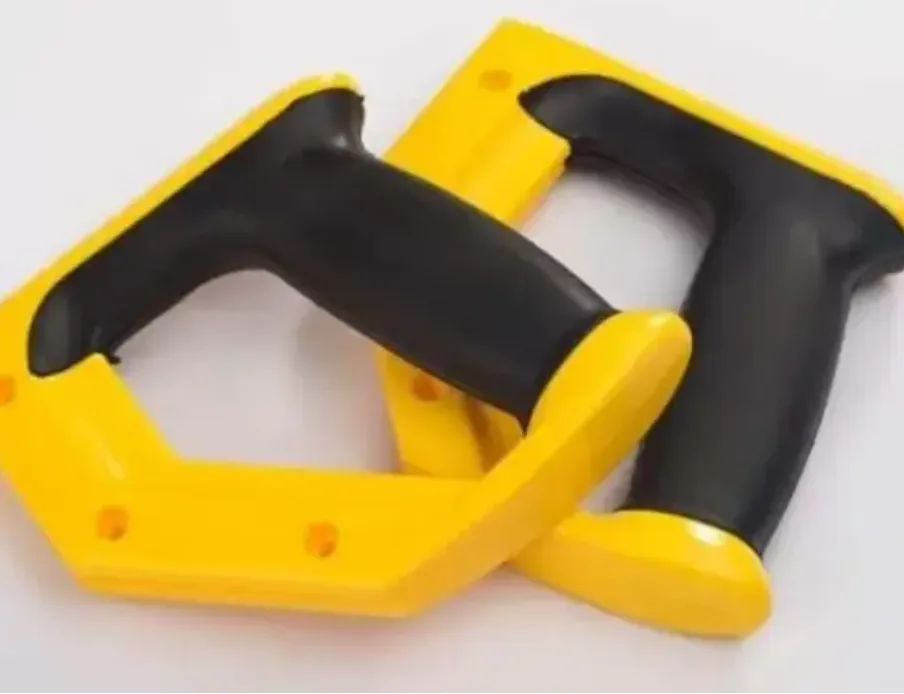In the world of plastic manufacturing, product performance and aesthetics often depend on more than just material selection or mold precision. Overmolding injection service has become a cornerstone process for creating durable, ergonomic, and visually appealing products. This guide explores everything you need to know about overmolding — from its definition and process to material choices, design guidelines, and applications across industries.
1. What Is Overmolding Injection?
Overmolding is an advanced plastic injection process that combines two or more materials into a single part. Typically, it involves molding a soft, flexible material — such as thermoplastic elastomer (TPE) or thermoplastic polyurethane (TPU) — over a rigid substrate, often made from ABS, PC, PP, or nylon.
The purpose of overmolding is to enhance functionality, comfort, and design aesthetics. For instance, a toothbrush handle with a soft grip or a power tool with a non-slip coating are perfect examples of overmolded products. The first layer, known as the substrate, provides structure and strength, while the overmold adds tactile comfort, insulation, or chemical protection.
Modern manufacturers are turning to overmolding to combine durability, comfort, and visual precision in a single component. This process bonds multiple materials to enhance product strength and user appeal.
LZ tooling, a provider of custom overmolding services, uses advanced TPE materials and precision molds to ensure strong adhesion, smooth finishes, and efficient production. These overmolding solutions highlight how material expertise and tooling accuracy drive performance and design quality.
2. How the Overmolding Process Works
Although overmolding appears complex, it’s essentially a combination of precise engineering and controlled molding stages. Here’s how it typically works:
Step 1: Substrate Preparation
The process begins with the creation of the base part — usually through traditional injection molding. The substrate must be clean, dimensionally stable, and properly conditioned to ensure good adhesion during overmolding.
Step 2: Mold Setup
The substrate is placed into a second mold designed specifically for the overmold material. This mold includes cavities that define where the secondary material will flow and bond.
Step 3: Overmold Injection
Once in position, molten overmolding material (like TPE) is injected at a controlled temperature and pressure. It flows over or around specific areas of the substrate, forming a strong mechanical and chemical bond.
Step 4: Cooling and Ejection
After the molten material solidifies, the part is cooled and ejected. Post-molding processes such as trimming, inspection, and testing ensure dimensional accuracy and bond strength.
Step 5: Finishing and Quality Check
Depending on the product’s application, the finished component may undergo surface finishing, adhesion testing, or assembly. Quality control ensures that every overmolded piece meets mechanical and aesthetic standards.
3. Types of Overmolding Processes
There are several variations of overmolding, each tailored for different production goals and material combinations.
(1) Two-Shot (Multi-Shot) Injection Molding
In this method, two materials are injected in sequence within a single machine. The first material forms the substrate, and the second forms the overmold — all in one continuous process. This approach improves precision and adhesion, ideal for high-volume production.
(2) Insert Overmolding
This involves molding a secondary material over a preformed insert — which can be metal, plastic, or another component. It’s commonly used in producing items like screwdrivers, electrical connectors, and medical devices.
(3) Co-Injection Molding
In this process, two materials are injected simultaneously to form a layered structure. It provides excellent bonding and surface finish but requires advanced machinery and careful control.
(4) Chemical Bond Overmolding
Some overmolding techniques rely on chemical adhesion rather than mechanical interlocking. Surface treatments or primers may be applied to promote strong bonding between dissimilar materials.
4. Material Selection for Overmolding
Choosing the right material combination is crucial. The goal is to ensure compatibility between the substrate and overmold material for optimal adhesion and performance.
Common Substrate Materials
- ABS (Acrylonitrile Butadiene Styrene): Strong, rigid, and easy to mold; ideal for consumer products.
- PC (Polycarbonate): Offers impact resistance and dimensional stability.
- PP (Polypropylene): Lightweight and chemically resistant.
- PA (Nylon): Excellent mechanical strength and heat resistance.
Common Overmold Materials
- TPE (Thermoplastic Elastomer): Provides flexibility, soft touch, and vibration damping.
- TPU (Thermoplastic Polyurethane): Excellent abrasion and chemical resistance.
- Silicone Rubber: Used for medical, automotive, and sealing applications.
- Santoprene: Offers high durability and a smooth finish.
Material Compatibility
Not all materials bond well. For instance, PP pairs best with TPEs designed for olefin substrates, while PC or ABS works better with styrenic-based elastomers. Material suppliers often provide compatibility charts or adhesion data sheets to guide selection.
5. Advantages of Overmolding
Overmolding offers a combination of functional and aesthetic benefits that make it an attractive choice for manufacturers across industries.
Enhanced Ergonomics
Soft-touch grips and flexible surfaces improve user comfort and reduce fatigue, especially in handheld tools or consumer electronics.
Improved Durability
By creating a unified structure with multiple layers, overmolding increases resistance to impact, moisture, and wear.
Aesthetic Appeal
Overmolding allows for color contrast, unique textures, and branding without secondary painting or labeling.
Vibration and Noise Reduction
The elastomer layer acts as a shock absorber, ideal for electronic housings or mechanical assemblies.
Sealing and Protection
Overmolding can create tight seals against water, dust, and chemicals, extending product life in harsh environments.
Cost Efficiency
Despite the added molding step, overmolding can eliminate assembly operations, adhesives, or fasteners — reducing labor and material costs.

6. Design Considerations for Overmolding
Proper design ensures strong bonding and efficient production. Here are key points to consider:
A. Undercuts and Retention Features
Incorporate mechanical interlocks or undercuts to enhance adhesion between layers, especially when chemical bonding is weak.
B. Wall Thickness
Maintain a consistent wall thickness to prevent sink marks, voids, or warping. Typically, the overmold layer should be between 0.5–2.5 mm thick, depending on part size and material.
C. Venting and Flow
Adequate venting prevents trapped air, while proper gate placement ensures smooth material flow and uniform coverage.
D. Surface Texture
A slightly roughened or etched substrate surface improves adhesion. Avoid glossy finishes where bonding is required.
E. Shrinkage and Tolerance
Different materials shrink at different rates; design molds with compensating tolerances to maintain precision.
F. Chemical Compatibility
Avoid combinations that lead to delamination or warping. Always test adhesion between substrate and overmold before mass production.
7. Common Challenges in Overmolding
Even with precise design and process control, overmolding can present challenges:
1. Poor Adhesion
This can result from contamination, incompatible materials, or improper processing temperature. Cleaning and surface activation (like plasma treatment) can enhance bonding.
2. Warpage
Differences in shrinkage or cooling rate between materials can cause deformation. Optimizing mold temperature and cooling channels helps mitigate this.
3. Flash or Overflow
Overfilling or misalignment can cause material to leak outside the intended area. Proper clamping and mold maintenance prevent this issue.
4. Color Bleeding
When using multiple colors, the pigments may blend undesirably. Careful temperature control and colorant selection are essential.
5. Short Shots
Incomplete filling due to air traps or low injection pressure leads to defective parts. Adjusting gating design and injection speed solves most cases.
8. Applications of Overmolding
Overmolding is widely used across multiple sectors, proving its versatility and reliability.
Consumer Goods
Products like toothbrushes, razors, and kitchen utensils use overmolding for comfort and appearance.
Automotive
Dashboard panels, switches, and grips benefit from soft-touch coatings and vibration damping.
Medical Devices
Handles of surgical instruments and diagnostic tools require comfortable grips and easy cleaning — ideal for TPE overmolding.
Electronics
Mobile phone casings, remote controls, and wearables use overmolding for protection and ergonomics.
Industrial Equipment
Tools, connectors, and housings rely on overmolding for sealing and shock resistance.
Sporting Goods
Overmolding enhances durability and grip in items like bicycle handles, fitness gear, and sports accessories.

9. Quality Control in Overmolding
Ensuring high-quality results involves strict process monitoring and testing. Key quality control methods include:
- Adhesion Testing: Measures bond strength between layers.
- Dimensional Inspection: Ensures consistency across batches.
- Material Verification: Confirms resin grade and compatibility.
- Color Consistency Check: Ensures visual uniformity for consumer products.
- Environmental Resistance Tests: Validates performance under humidity, heat, or chemical exposure.
Automated inspection systems using vision sensors or 3D scanning can further enhance precision and reliability.
10. Future Trends in Overmolding
As technology evolves, overmolding is moving toward more sustainable and efficient methods:
Eco-Friendly Materials
Biodegradable and recycled polymers are being developed for both substrates and overmolds.
Lightweight Structures
Overmolding with advanced composites reduces weight while maintaining strength — valuable for automotive and aerospace industries.
Smart Integration
Embedding sensors, circuits, or RFID chips during overmolding enables smart and connected devices.
Automation and Digital Twin Technology
Automated handling, robot-assisted insert placement, and digital simulation improve cycle time and process predictability.
Conclusion
Overmolding injection service represents a perfect blend of engineering precision, material science, and design creativity. It allows manufacturers to produce products that are not only durable and functional but also visually appealing and user-friendly. From automotive components to consumer goods and medical devices, the advantages of overmolding are clear — better performance, stronger bonding, and a premium finish.
As materials and technologies continue to evolve, overmolding will remain at the forefront of modern plastic manufacturing. Whether for enhancing grip, improving ergonomics, or achieving seamless integration of multiple materials, this process continues to redefine how high-quality plastic parts are made.








